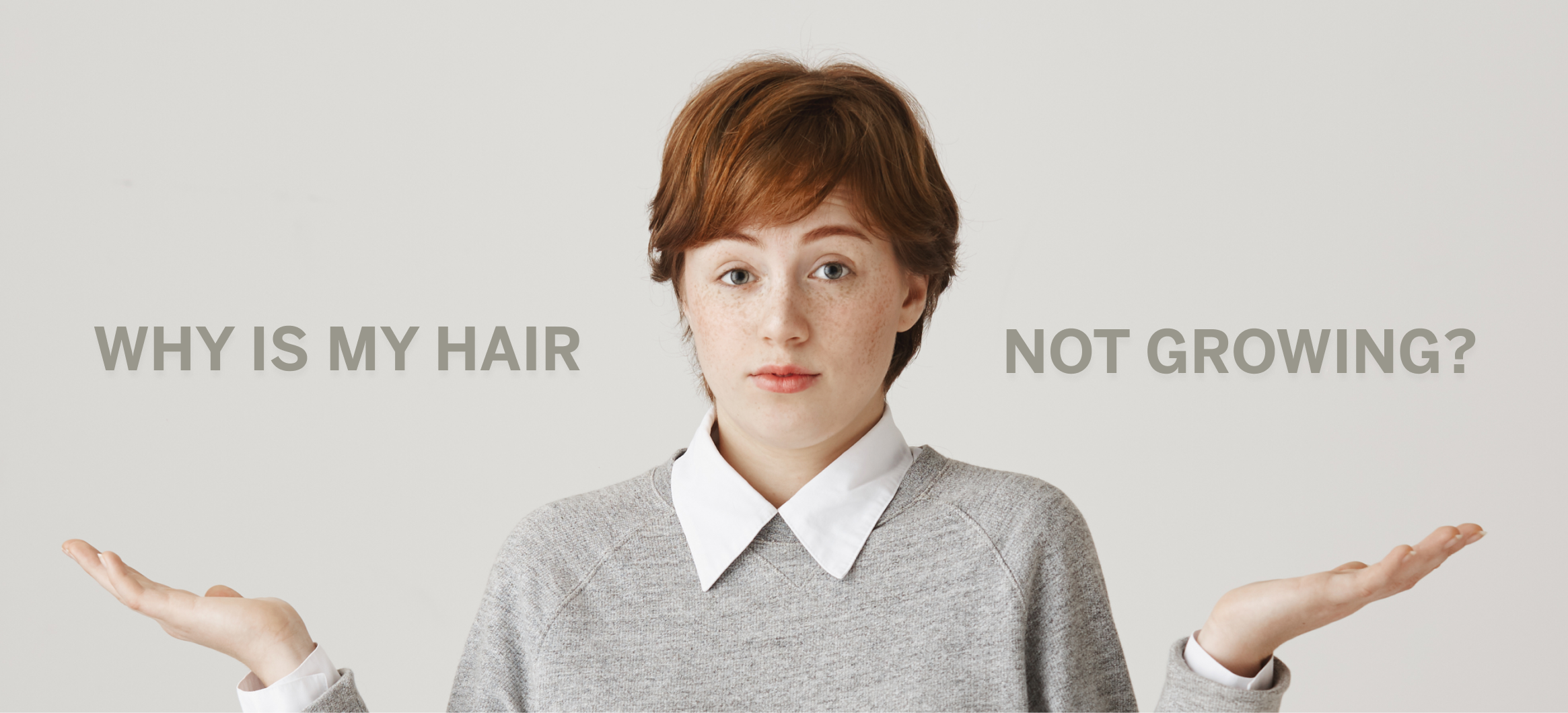Hair loss is never easy to accept, but most people know that it comes with getting older. Losing hair at a young age, however, is a different story. For teenagers and twenty-somethings, unexpected hair loss can be a distressing experience. Fortunately, there are ways to reduce the chances of further hair loss. Let’s take a deep dive into what causes hair loss at a young age and options for addressing the issue.
Typical Daily Hair Loss
The body loses hair each day as a natural part of each hair’s growth cycle. The American Academy of Dermatologists estimates that a person loses about 50 to 100 strands daily. With approximately 100,000 hair follicles on an average human head, 100 strands a day doesn’t create a noticeable change. Hair loss that’s caused by hair’s natural growth cycle is called “shedding.” (01)
Furthermore, most people will experience some level of hair loss with age. Roughly 40% of women lose more hair each day than men, probably due to heated hair styling tools, regular hair coloring, and hormonal changes. (02) For both men and women, as people age, the rate of normal hair growth slows.
Hair Loss as a Teen or Young Adult
Losing hair at a young age is not typical. The teen years and young adulthood are a crucial time for building identity and self-confidence; hair loss at this stage can lead to low self-confidence and increased self-consciousness. (03) The following are a few potential causes of hair loss at a young age.
Alopecia areata
Alopecia areata is an autoimmune condition that results in balding patches throughout the head. In an autoimmune disorder, the body’s immune system mistakenly attacks healthy cells. Unfortunately, in the case of alopecia areata, it’s cells within hair follicles that are damaged by the immune system. As a result, the hair follicles weaken, which leads to hair loss.
About 2% of all people will develop alopecia areata sometime in life. Along with balding patches, the condition can also lead to hair loss on the body, eyebrows, or eyelashes. A majority of people who develop alopecia areata do so before the age of 30. In some cases, however, the condition may begin as early as adolescence or childhood. (04)
Malnutrition
A lack of appropriate nutrients can lead to malnutrition. It’s essential to understand the difference between calorie intake and nutrition. An individual may consume sufficient calories but remain malnourished. A diet consisting of high-calorie foods without an adequate amount of vital nutrients can lead to a state of malnutrition. Malnutrition may also result from not eating enough food or being unable to process foods appropriately.
To maintain a healthy head of hair, hair follicles need the proper nutrients from a well-rounded diet. The following are some of the most vital nutrients necessary for hair growth: (05)
- Vitamin A
- Vitamin C
- Vitamin D
- Vitamin E
- Niacin
- Zinc
- Biotin
- Iron
- Selenium
A few potential causes of malnutrition in adolescents and young adults are inadequate access to food, eating disorders, restrictive dieting, or health problems. Additionally, a teen diet full of junk food and low on nutrients can lead to hair loss!
A Family History of Hair Loss
People who have close relatives with hair loss are at a higher risk for androgenetic alopecia. Androgenetic alopecia, a genetic condition leading to hair loss, usually begins in adulthood. Although in some cases, this condition may start as early as adolescence. Both men and women can experience androgenetic alopecia, and other names for the condition are male-pattern baldness or female-pattern baldness.
In males, androgenetic alopecia is usually a gradual balding at the crown or hairline. For women, the condition begins as a slow thinning of hair throughout the head. Both teenage boys and girls can develop androgenetic alopecia, particularly if there’s a family history of the condition. (06)
Polycystic Ovary Syndrome
Polycystic ovary syndrome, also known as PCOS, causes an excess of androgens (male sex hormones) in women and girls of reproductive age. This hormone imbalance can result in female hair loss, even in teenage girls.
Women typically produce low levels of male hormones, but PCOS causes an overproduction of them. Due to these extra androgen levels, a woman with PCOS might develop masculine features and hair loss, especially throughout the head. Thinning hair due to hormonal imbalance such as PCOS is called androgenic alopecia or female pattern hair loss. (07)
Thyroid Conditions
The thyroid is a small — but powerful — gland. This gland at the neck produces hormones that control metabolism, heart rate, and mood. The thyroid also manages how the body uses oxygen and controls growth, which is why a low-functioning thyroid (hypothyroidism) can lead to hair loss at any age.
Thyroid hormones keep hair growing consistently. Without enough thyroid hormones in the system, the hair’s shedding phase lengthens. More hair is shed, and less hair grows, leading to hair loss. Symptoms of an under-functioning thyroid include: (08)
- Depression
- Tiredness
- Unexplained weight gain
- Constipation
- Dry skin
- Puffy or swollen face
- Joint pain
- Irregular menstrual cycle
People of all ages can experience thyroid issues. In children and adolescents, untreated thyroid disorders can lead to developmental delays. Thyroid conditions require medical treatment and should not be overlooked.
Lupus
Like alopecia areata, lupus is an autoimmune condition. Though lupus is typically known for its hallmark symptom of a “butterfly-shaped” rash on the face, another symptom people with lupus experience is hair loss. Unlike alopecia areata, however, two types of hair loss are associated with lupus: scarring and non-scarring.
Non-scarring hair loss stems from the inflammation caused by lupus. Widespread inflammation can affect the scalp and hair follicles, resulting in non-scarring hair loss. With lupus, hair loss may occur all over the body, including the eyebrows and external limbs.
Lupus also causes discoid sores that may result in permanent scars. These sores, lesions, and scars can damage hair follicles, resulting in “scarring” hair loss. The hair loss doesn’t cause scarring. Instead, the scarring from lupus can prevent hair from growing, possibly making hair loss in most areas permanent. (08)
Telogen Effluvium
Does stress cause hair loss? Sometimes. Telogen effluvium is a temporary hair loss caused by physical or psychological stress. Events like severe illness, psychological trauma, childbirth, or significant weight loss can result in telogen effluvium.
Telogen effluvium is a temporary form of hair loss that causes excessive hair shedding. Stress, illness, childbirth, or weight loss are some of the many potential causes. Fortunately, this condition typically resolves itself after the stress lifts.
Traction Alopecia
A tight bun or high ponytail may look chic, but it can pull hair and cause hair loss. Tight hats or headgear may also cause loss of hair over time. This type of hair loss is called traction alopecia and occurs in both men and women.
In traction alopecia, repeated pulling may cause small pimple-like bumps on the scalp. As traction alopecia worsens, hair begins to fall out. Other symptoms of traction alopecia are: (09)
- Scalp Redness
- Folliculitis
- Scalp tenderness
- Itching
- Scaling
Identifying and addressing traction alopecia in its early stages is essential because if follicles become too damaged, they will no longer produce and hold new hair.
Hair Styling and Treatments
Experimenting with hair color is part of adolescence for many teens, and a bottle or two of Manic Panic purple dye will (most likely) not result in hair loss. Bleaching hair, however, can dry hair out and make strands brittle, resulting in breakage. Furthermore, heated styling tools and chemical straighteners also damage hair and lead to broken strands.
The good news is that these processes don’t usually affect the scalp or hair follicles. However, this can make the hair appear thinner and unhealthy. To prevent breakage, try to keep the use of heated tools to a minimum and use them at a low setting.
Hair Loss in Teen and Young Adults: Should You Worry?
Thinning hair and balding can occur at any age for various reasons. Obtaining an assessment and treatment as soon as possible, especially for adolescents and young adults, can help prevent issues with self-esteem and improve the chances of successful hair growth.
Happy Head includes an assessment from a licensed dermatologist with every subscription, ensuring that each person gets to the root of their problem! Every treatment is individualized, and ongoing support is there to help you every step of the way. Take advantage of Happy Head’s six-month money-back guarantee and see what Happy Head can do for you.








.png)


